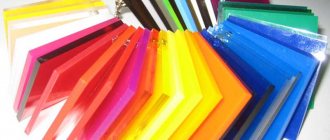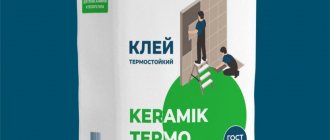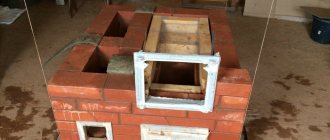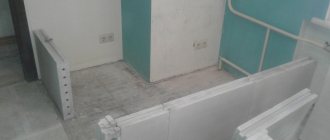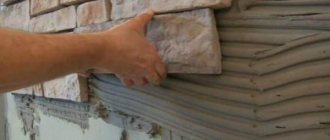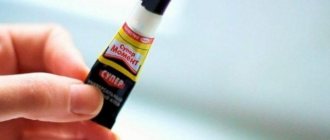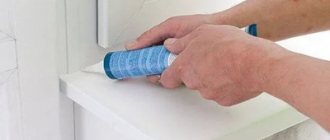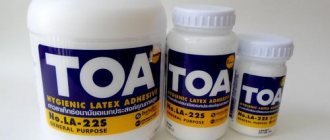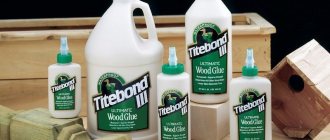What is liquid plastic for windows?
Liquid plastic is a one-component adhesive based on dissolved white PVC adhesive. Its basis is polyvinyl chloride, which is vinyl chloride in the form of a thermoplastic polymer. Externally it looks like transparent plastic. To give it a white color, special components are added to the plastic to give it a white color.
Rice. 1. Scheme of diffuse welding of gaps using liquefied
This composition is identical to the solid polymer product of PVC window blocks and slopes, so the plastic sealant fits perfectly with their surface.
Bonding is carried out due to the diffuse penetration of the adhesive element into the PVC surface of the block. It turns out a kind of welding of the connected places with the formation of a strong seam.
Instructions for using liquid plastic for windows
Rice. 2. Correct application of polymer glue along the seam line.
For proper use of polymer glue, instructions for use are included when purchasing it. The main actions when using the product should be the following:
- The adhesive composition must be applied to the surfaces of the parts to be joined by directly squeezing it out of the tube. To do this, put a conical cap on the tube, from which the end is cut off.
- Pre-glued surfaces must be cleaned of dirt and dust and degreased.
- The glue should be applied in a thin continuous line along the joint line (photo below).
- You can touch the surface after the polymer joint has completely dried.
- After processing the joints, it is recommended to thoroughly ventilate the room.
Features of use and application
Before the application process, you must strictly adhere to the technology and how to use liquid plastic for windows.
- From the surface that will be covered with the material, you need to remove dirt, dust and dry it, then degrease it with acetone. This stage is important for adhesion of the composition to the surface.
- Place a conical cap on the tube and cut off the end.
- Next, squeeze out a strip of medium thickness and continuously apply the compound along the seam of the joints.
- Wait for complete drying for 15-20 minutes.
- If the material shrinks in the crack, the substance should be reapplied to this area.
Thus, if all conditions are met, then the slopes, window sill and ebbs will be a single monolithic connection.
Disadvantages of conventional sealants
When sealing cracks in window joints with conventional sealants, after some time problems arise due to their shortcomings during operation. Most often, silicone and acrylic sealants are used to seal cracks. Each of them has its own shortcomings that manifest themselves over time.
Rice. 3. A seam that has turned yellow during use of windows, made with acrylic sealant.
Their essence is as follows:
- Acrylic-based sealants, once cured, become porous and begin to absorb dust, dirt, odors, cigarette smoke and anything else present in the environment. As a result, the seam acquires a dirty yellow color, which looks unsightly (see Fig. 3).
- Silicone sealants have a transparent appearance and form a barely noticeable film after drying. When using windows, such a film begins to peel off and lag behind the surface, forming rags (see Fig. 4).
Rice. 4. The difference between seams made with silicone sealant and “liquid plastic”
The technology for applying liquid plastic and the disadvantages of other sealants are shown in the video:
Advantages of liquid plastic for windows
The use of a polymer adhesive composition for sealing window joints provides many advantages, which are provided by the technological properties of this product.
Rice. 5. A type of seam made using liquid plastic, completely compatible with the material of the slopes, window blocks and window sill.
Their essence is as follows:
- The joining seam is welded with a material identical to the material used in the production of slopes and window frames, which provides an optimal combination of bonded surfaces. They are both made of PVC, so their structure is the same. (Fig. 5).
- When the polymer hardens, a monolithic structure is formed from a slope and a window block. The welded joint has high strength.
- The seam area is not exposed to fungi, mold and corrosion during the entire period of operation of the windows.
- The monolithic seam forms a smooth surface and does not change its color under the influence of UV rays. (Fig. 6)
- The chemical composition of the polymer meets environmental safety requirements.
- The operation of such windows without breaking the seal after treatment with this product is guaranteed by the manufacturer for 15–20 years.
Rice. 6. A seam that has retained its appearance and color after prolonged use of the windows.
Advantages and disadvantages
Liquid plastic adhesives have a lot of advantages. Despite their recent appearance on the market, they have firmly gained popularity among window manufacturers.
The use of glue ensures diffuse welding (mutual penetration) in the joint area, resulting in the formation of a single part without changes in color or structure. This is achieved due to the fact that the liquid plastic has approximately the same composition as the PVC profiles themselves.
Other advantages of the series:
- resistance to precipitation, light, heat, ultraviolet radiation;
- absence of fungus and mold at the joint, even at high humidity;
- excellent strength, seam strength;
- environmental safety, harmlessness to humans;
- guarantee of color retention for 15 years (the seam will remain white or transparent);
- rapid hardening, the ability to quickly put the product into operation;
- good sealing of seams, protection from cold and drafts;
- no absorption of odors;
- the ability to use detergents;
- resistance to sub-zero temperatures.
The disadvantages include too rapid setting of surfaces. You should immediately position them correctly, since there will be no time to correct the location. Another disadvantage is the need for the product to be completely dry during operation; only after hardening will the joint be resistant to moisture.
The disadvantage is that some adhesives are difficult to separate from surfaces, which requires purchasing a special solvent. Liquid plastic does not work well on porous surfaces and is not suitable for producing elastic, moving seams.
Another serious disadvantage is the easy ignition of materials - you must work with them in strict compliance with safety measures.
The need to use liquid plastic for windows
When installing new PVC windows to replace the old ones, the slopes are replaced at the same time or the plastered openings are lined with plastic panels. In order for the joints of window blocks with slopes to be airtight, to form a single monolith and to look aesthetically pleasing, it is necessary to use a sealant that meets these qualities. Liquid plastic, like no other, is suitable for these purposes.
Interior finishing works
The need to use this polymer adhesive for windows for the purpose of decorating and finishing the surface is due to its property of giving butt joints an inconspicuous appearance due to the uniform color. In addition to sealing seams between slopes and window blocks, liquid polymer is necessary for masking technological seams, securing auxiliary elements: flashings, protective strips, drains and other elements.
Anti-corrosion treatment
In addition to its direct purpose for sealing joints of PVC windows, the polymer adhesive composition is used for anti-corrosion treatment, taking into account its resistance to aggressive environments. It is used to cover elements of window structures that are susceptible to corrosion: awnings, metal rain gutters, etc. This sealant is also indispensable when connecting pipes.
Technology of using liquid plastic for windows
The process of sealing joints between PVC blocks and slopes should be carried out in accordance with the technology outlined below:
- According to the instructions for using the product, before using plastic sealant, the joining surfaces must be cleaned and degreased.
- To clean the welding area, it is better to use lint-free wipes to prevent it from getting on the surface to be glued.
- As a cleaning agent, it is recommended to use products produced by the same manufacturer, for example Cosmofen-10 and Cosmofen-60. For surfaces resistant to acetone, in exceptional cases it can be used.
- The process of applying glue must be carried out on a dry surface to ensure maximum adhesion to the surface. The maximum tightness of the seam depends on this.
- The length of the joint line should not exceed 0.4 - 0.5 m to prevent rapid drying of the applied sealant.
- After applying the adhesive, it must be lightly pressed down for maximum fixation, for example, with a finger dipped in water. But it is better to prepare a plastic spatula, which must be moistened in water and detergent before pressing on the seam. This is necessary in order to prevent the glue from sticking to the glue that has not yet dried.
- It takes 16-20 hours for the applied product to dry completely, and the maximum strength of the seam occurs after 1.5 - 2 months.
One method of applying polymer adhesive using wiping with detergent-based soap is shown in the video:
COSMOFEN PMMA glue for plexiglass, 200g (colorless)
Detailed information:
Ideal for quick structural bonding of acrylic parts and is characterized above all by good resistance to thermal stress and good resistance to UV stress. Application: Rapid structural bonding of acrylic elements Window production: Bonding of additional profiles (acrylic bonded surfaces) to acrylic load-bearing profiles obtained by co-extrusion Manufacturing of display cases: structural bonding of acrylic plates to each other Characteristics: Base - PMMA polymers in solvent Color in the cured state - colorless Viscosity measured using the cone-plate method (1,000 s-1) at +25 °C - approx. 2,600 mPa s Density according to EN 542 at +20 °C - approx. 0.92 g/cm3 Open time at +20 °C, 50% rel. vl., applied amount 150 microns - glass - approx. 40 s Functional strength when gluing planks without tension - approx. 2-4 min. Curing time at +20 °C, 50% rel. ow. Up to 90% – approx. 24 h Diffusion of residual solvent can continue for up to 8 weeks. Application quantity Bonding surface 20 mm wide - approx. 8 g/lm bonding surface 40 mm wide - approx. 16 g/linear meter Minimum application temperature - from +5 °C Technology of use: General information Diffusion adhesives can forcefully bridge only adhesive gaps <0.1 mm! When gluing transparent boards, the bonded surface becomes cloudy due to softening by the solvent! The time parameters indicated here can only be accurately determined by personal testing, since these parameters significantly depend on the material, temperature, amount applied, air humidity, material moisture, thickness of the adhesive layer, contact pressure and other factors. As a rule, appropriate corrections must be made to the specified guideline values to ensure reliability. Preparation The product must be acclimatized before use. The surfaces to be bonded must be clean, dry and free of grease. In this case, COSMOFEN 60 cleaner for aluminum is recommended. The cleaning wipes used should not shed or lint. Cleaning Cleaning of working instruments from uncured glue is carried out using COSMOFEN 10 plastic cleaner. Cleaning of metal surfaces is carried out simply by removing the hardened adhesive film, since there is no adhesion to the metal.
Cosmofen
Among the line of polymer sealants, Cosmofen deserves attention. The manufacturer of this product is German, which uses cyanoacrylate as the base of the adhesive sealant. It has instant bonding properties. Basically, very high-quality adhesive compositions “COSMOFEN” with whitening components are used for plastic frames.
Cosmofen is supplied for sale at an affordable price in sealed tubes or a tube with a gun design.
Rice. 7. One of the varieties of packaging for polymer glue “COSMOFEN”
This polymer composition does not react to fungi and is a corrosion-resistant material. In addition, it never changes its white color during the use of windows, unlike conventional sealants, which turn yellow over time. Therefore, the joint location does not differ in color from the PVC surface of the window block.
When working with Cosmofen, you should be guided by the technology used for all liquid plastics, taking into account its characteristics:
- After application to the surface, it retains its adhesive ability for 1 minute;
- when performing work, such a sealant provides maximum effect at a relative humidity of 60% and an optimal temperature range from +20°C to +5°C;
- the consumption of the adhesive composition should approximately correspond to the volume of 150g/m2;
- The hardening time of the sealant is 2 - 4 minutes; it takes at least a day to complete the hardening process;
- The ignition temperature of the product is +321°C.
Advantages
Liquid plastic has recently appeared on the market and has virtually no disadvantages. This sealant uses the principle of diffuse welding, that is, it has the property of ideally welding surfaces in places where parts come into contact. Consequently, after applying the glue, a single part is formed in the problem area, without any color or other modifications.
Butt window treatment using liquid plastic has the following positive properties:
- joining seams are treated with the same material as is used for slopes and windows;
- high density of parts bonding;
- after complete hardening, a monolithic part is formed at the gluing (welding) site, where there will be absolutely no gaps between the slope part and the window;
- the desired effect is achieved through the use of diffuse welding - a technology that provides for the mutual penetration of parts;
- mold or mildew will never form in the place where the treatment was carried out, and the seam itself is characterized by sufficient strength;
- the sealant is absolutely safe for health and does not harm the environment;
- The manufacturer's stated warranty regarding the sealant indicates that the formed seam will not be subject to change for at least 15 years.
Price
For a 200 g tube only 275 rubles. You can buy it at any hardware store.
Finishing slopes of plastic windows using liquid plastic
The installation process does not end with the installation of new plastic blocks and additional finishing of window openings is required. Therefore, after installing glazed window frames, there is always a need to finish the slopes. This is due to a number of reasons:
- Slopes increase the thermal insulation of the room, maintaining its microclimate;
- These elements serve as additional protection against noise;
- The design of the window slopes gives the windows completeness.
In order for plastic slopes to look in one ensemble with the windows and perform all the tasks assigned to them, their finishing should be approached with special care and the connection with the window structure should be carried out as carefully as possible.
Finishing with liquid plastic is the final stage of the installation of slopes. With its help, you can successfully solve the problem of not only sealing slopes, but also decorating them. To do this, the joint area is treated with this polymer not only between the window frame profile and the slope panels, but also between the slope panel located at the top and the side facing panel. The seams perpendicular to the window between the side slopes and the window sill are sealed from below.
With proper, careful finishing, a single harmonious design of the window opening is obtained.
Rice. 8. Places for treating slopes with liquid plastic and their appearance after finishing
